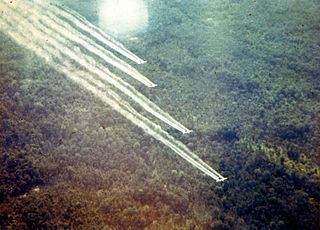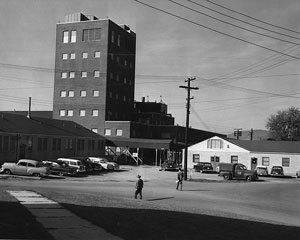
Biological warfare (BW)—also known as germ warfare—is the use of biological toxins or infectious agents such as bacteria, viruses, insects, and fungi with the intent to kill or incapacitate humans, animals or plants as an act of war. Biological weapons are living organisms or replicating entities. Entomological (insect) warfare is a subtype of BW.

Fort Detrick is a United States Army Medical Command installation located in Frederick, Maryland. Historically, Fort Detrick was the center of the U.S. biological weapons program from 1943 to 1969. Since the discontinuation of that program, it has hosted most elements of the United States biological defense program.

A biological agent is a bacterium, virus, protozoan, parasite, or fungus that can be used purposefully as a weapon in bioterrorism or biological warfare (BW). In addition to these living or replicating pathogens, toxins and biotoxins are also included among the bio-agents. More than 1,200 different kinds of potentially weaponizable bio-agents have been described and studied to date.

Herbicidal warfare is the use of substances primarily designed to destroy the plant-based ecosystem of an area. Although herbicidal warfare use chemical substances, its main purpose is to disrupt agricultural food production and/or to destroy plants which provide cover or concealment to the enemy, not to asphyxiate or poison humans and/or destroy human-made structures. Herbicidal warfare has been forbidden by the Environmental Modification Convention since 1978, which bans "any technique for changing the composition or structure of the Earth's biota".

The United States Army Medical Research Institute of Infectious Diseases is the U.S Army's main institution and facility for defensive research into countermeasures against biological warfare. It is located on Fort Detrick, Maryland and is a subordinate lab of the U.S. Army Medical Research and Development Command (USAMRDC), headquartered on the same installation.
William C. Patrick III was an influential microbiologist and bioweaponeer for the U.S. Army during the Cold War.
The National Biodefense Analysis and Countermeasures Center (NBACC) is a government biodefense research laboratory created by the U.S. Department of Homeland Security (DHS) and located at the sprawling biodefense campus at Fort Detrick in Frederick, MD, USA. The NBACC is the principal U.S. biodefense research institution engaged in laboratory-based threat assessment and bioforensics. NBACC is an important part of the National Interagency Biodefense Campus (NIBC) also located at Fort Detrick for the US Army, National Institutes of Health and the US Department of Agriculture.

The One-Million-Liter Test Sphere—also known as the Test Sphere, the Horton Test Sphere, the Cloud Study Chamber, Building 527, and the “Eight Ball” —is a decommissioned biological warfare (BW) chamber and testing facility located on Fort Detrick, Maryland, USA. It was constructed and utilized by the U.S. Army Biological Warfare Laboratories as part of its BW research program from 1951 to 1969. It is the largest aerobiology chamber ever constructed and was placed on the National Register of Historic Places in 1977.
The United States biological weapons program began in 1943 and was discontinued in 1969.

Building 470 — also called the Pilot Plant, or sometimes “the Tower”, or “Anthrax Tower” — was a seven-story steel and brick building at Fort Detrick in Frederick, Maryland, United States, used in the small-scale production of biological warfare (BW) agents. The building, a Cold War era structure, was transferred from the Department of Defense to the National Cancer Institute-Frederick in 1988, to which it belonged until 2003 when it was demolished.
The M115 anti-crop bomb, also known as the feather bomb or the E73 bomb, was a U.S. biological cluster bomb designed to deliver wheat stem rust.

Saddam Hussein (1937–2006) initiated an extensive biological weapons (BW) program in Iraq in the early 1980s, in violation of the Biological Weapons Convention (BWC) of 1972. Details of the BW program—along with a chemical weapons program—surfaced only in the wake of the Gulf War (1990–91) following investigations conducted by the United Nations Special Commission (UNSCOM) which had been charged with the post-war disarmament of Saddam's Iraq. By the end of the war, program scientists had investigated the BW potential of five bacterial strains, one fungal strain, five types of virus, and four toxins. Of these, three—anthrax, botulinum and aflatoxin—had proceeded to weaponization for deployment. Because of the UN disarmament program that followed the war, more is known today about the once-secret bioweapons program in Iraq than that of any other nation.
Building 257, also known as Lab 257, was a United States biological warfare research laboratory located at Fort Terry on Plum Island, New York. Originally intended for munitions storage, the facility researched anti-animal biological agents beginning in 1952 under the United States Army. Biological warfare research continued in the building under the United States Department of Agriculture (USDA) until a new laboratory was completed.
The Vigo Ordnance Plant, also known as the Vigo Chemical Plant or simply Vigo Plant, was a United States Army facility built in 1942 to produce conventional weapons. In 1944 it was converted to produce biological agents for the U.S. bio-weapons program. The plant never produced any bio-weapons before the end of World War II but did produce 8000 pounds of an anthrax simulant. The plant was transferred to Pfizer after the war; the company operated it until announcing its closure in 2008.
The Granite Peak Installation (GPI) — also known as Granite Peak Range — was a U.S. biological weapons testing facility located on 250 square miles (650 km2) of Dugway Proving Ground in Utah. The GPI was a sub-installation of Dugway but had its own facilities, including utilities. Established in 1943, GPI was deactivated with the end of World War II.

Horn Island Chemical Warfare Service Quarantine Station, also known as the Horn Island Testing Station, was a U.S. biological weapons testing site during World War II. It was located on Mississippi's Horn Island and opened in 1943. When the war ended, the facility was closed.
The United States biological defense program—in recent years also called the National Biodefense Strategy— refers to the collective effort by all levels of government, along with private enterprise and other stakeholders, in the United States to carry out biodefense activities.

Herbicidal warfare research by the U.S. military began during the Second World War with additional research during the Korean War. Interest among military strategists waned before a budgetary increase allowed further research during the early Vietnam War. The U.S. research culminated in the U.S. military defoliation program during the Vietnam war known as Operation Ranch Hand.

Riley D. Housewright was an American microbiologist who conducted research on germ warfare. Having been assigned to the Fort Detrick laboratory in the mid-1940s and appointed scientific director in 1956, Housewright played a major role in the development of bioweapons for a proposed attack on Cuba during the Cuban Missile Crisis. In 1966, he was appointed president of the American Society for Microbiology. He left Fort Detrick in 1970 following President Nixon's moratorium on US bioweapons research, and later published several books on water safety for the National Academy of Sciences. In the 1980s, Housewright became executive director of the American Society for Microbiology. He died in Frederick, Maryland, in 2003.









